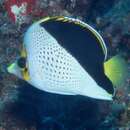ar
الأسماء في صفحات التنقل


The Hawaiian butterflyfish (Chaetodon tinkeri), also known as Tinker's butterflyfish, is a marine ray-finned fish, a butterflyfish belonging to the family Chaetodontidae of order Perciformes. It is found in the central Pacific Ocean.
It grows to a maximum length of 15 cm (5.9 in). It swims alone or in pairs and occasionally in small aggregations. Its coloring is divided on the diagonal between black and white. It has gold dorsal and tail fins, and a gold vertical bar across its eyes.[2] The dorsal fin has 13-14 spines and 18-22 soft rays while the anal fin has 3 spines and 16-18 soft rays. It attains a maximum total length of 15 centimetres (5.9 in).[3]
This fish inhabits Hawaii, Johnston Atoll and the Marshall Islands in the tropical Pacific Ocean. It prefers steep slopes, near black corals at depths of 27–135 m (89–443 ft).[2][3]
The Hawaiian butterflyfish feeds on a variety of planktonic and benthic organisms.[3]
The Hawaiian butterflyfish was first formally described by the American ichthyologist Leonard Peter Schultz (1901-1986) in 1952 with the type locality given as Nanakuli on Oahu in Hawaii.[4] The specific name honours Spencer W. Tinker who discovered it in 1949, trapping them in fish traps at 90 feet (27 m) off Oahu, Hawaii.[2]
These fish are somewhat popular in aquaria.
The Hawaiian butterflyfish (Chaetodon tinkeri), also known as Tinker's butterflyfish, is a marine ray-finned fish, a butterflyfish belonging to the family Chaetodontidae of order Perciformes. It is found in the central Pacific Ocean.